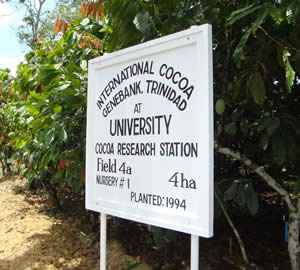Genetic Resource Management
Populations | Donate | Enhancement | Distribution | Genomics | Flavour | Screening
Management of the Genebank: ICG,T
Cocoa trees are planted in plots of 16. It is a system designed to quickly obtain a closed canopy, that will withstand periods of low input with minimum risk to the genetic material. This design works well for cocoa accessions which are easy to establish from cuttings, but for others, gaps in the canopy make weed control a constant problem.
Shade management is needed, particularly for newly planted cacao until it is established. Banana provides shade during the first few years, after which it is replaced by Erythrina spp. trees. Replacement of existing older shade trees, conserved when the ICG,T was planted, is on-going.
During the dry season in Trinidad (January to June), irrigation is necessary to ensure the survival of young trees and also rooted cuttings that lack the deep tap roots of seedlings. If accessions are difficult to establish from rooted cuttings, it may be necessary to conserve them by grafting their budwood onto rootstocks in a clonal garden. Once established, cuttings can be taken from this material and rooted to fill gaps in the ICG,T.
Field maps and databases are continuously updated to reflect changes in the plots. Each tree is given a unique number to accurately record the source of material for research and other purposes, so that identified off-types can be recognised.
Staff
A. Holder-John
Valmiki Singh
Establishment of the ICG,T
The International Cocoa Genebank, Trinidad (ICG,T) is one of the world’s most diverse collections of cacao germplasm. Designated a Universal Collection by Bioversity International (Formerly IPGRI*), the ICG,T is situated on an ~100 acre site, which was originally part of the La Reunion Estate at Centeno/La Chaguaramas.
ICG,T establishment began in 1982 by consolidating diverse earlier collections of cacao from several sites in Trinidad including accessions from other national collections and from numerous missions to collect primary germplasm from the centre of origin of cacao. Also included were the 100 Imperial College Selections (ICS) which resulted from an exhaustive survey of Trinidad and Tobago carried out by F.J. Pound between 1930 and 1935.
Trees in the ICG,T were propagated as rooted cuttings using budwood and by 1994, over 2,000 accessions had been planted. Additional clones are added as they become available.

Image copyright © Ed Seguine.
A main source of original material for the ICG,T was Marper Farm, established by Pound following his expeditions to the upper Amazon from 1937 to 1942. The trees at Marper though now old, have survived periods of neglect to remain an important anchor in confirming the identity of clones in the ICG,T and in replacing material which has proved difficult to establish.
*IPGRI – International Plant Genetic Resources Institute
More on the International Cocoa Genebank, Trinidad
Populations | Donate | Enhancement | Distribution | Genomics | Flavour | Screening


















